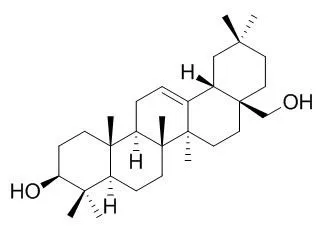| In vitro: |
| Mol Nutr Food Res. 2008 May;52(5):595-9. | | Erythrodiol, a natural triterpenoid from olives, has antiproliferative and apoptotic activity in HT-29 human adenocarcinoma cells.[Pubmed: 18384095] | Erythrodiol is the precursor of pentacyclic triterpenic acids present in Olea Europaea. Although olive oil and some of its constituents are reported to have anticarcinogenic activities, Erythrodiol has not been assessed in its cell biological functions in detail.
We therefore determined its effects on cell growth and apoptosis in human colorectal carcinoma HT-29 cells.
METHODS AND RESULTS:
Proliferation, cytotoxicity, and apoptosis were measured by fluorescence-based techniques. Erythrodiol inhibited cell growth with an EC50 value of 48.8 +/- 3.7 microM without any cytotoxic effects in a concentration range up to 100 microM. However, exposure of cells for 24 h to 50, 100, and 150 microM Erythrodiol increased caspase-3-like activity by 3.2-, 4.8-, and 5.2-fold over that in control cells.
CONCLUSIONS:
We here demonstrate for the first time that, in colon adenocarcinoma cells, Erythrodiol exerts antiproliferative and proapoptotic activity. | | Br J Nutr. 2004 Oct;92(4):635-42. | | Potential vasorelaxant effects of oleanolic acid and erythrodiol, two triterpenoids contained in 'orujo' olive oil, on rat aorta.[Pubmed: 15522132] | 'Orujo' olive oil is obtained by chemical processes from the waste resulting from the mechanical extraction of virgin olive oil. The aim of the present study was to evaluate a new pharmacological property of two natural triterpenoids contained in olive oil, as vasodilatory agents, and to determine their mechanism of action. The two compounds studied were oleanolic acid and Erythrodiol.
METHODS AND RESULTS:
The vasorelaxant effect induced by these pentacyclic triterpenoids was studied in isolated thoracic rat aorta. Oleanolic acid and Erythrodiol, accumulatively added, showed vasorelaxant activities in aortic rings with endothelium pre-contracted by 10(-6) m-phenylephrine (maximum percentage of relaxation 86.38 (sem 2.89) and 73.53 (sem 6.01), respectively). They had almost no relaxant effect on depolarised or endothelium-denuded aortic segments. The relaxation was significantly attenuated by pre-treatment with the NO synthase inhibitor N(omega)-nitro-L-arginine-methylester (L-NAME; 3x10(-4) m). To characterise the involvement of endothelial factors, in addition to NO, arteries with endothelium were exposed to 10(-5) m-indomethacin (INDO), a cyclo-oxygenase inhibitor, or INDO plus L-NAME. INDO did not have any significant effect on the relaxant response of both compounds. The combination of L-NAME plus INDO only abolished the oleanolic acid-induced relaxation.
CONCLUSIONS:
The present results suggest that the mechanism of relaxation seems to be mainly mediated by the endothelial production of NO; however, other mechanisms cannot be excluded. It can be concluded that oleanolic acid and Erythrodiol may have interesting therapeutic potential as new vasodilator drugs, thus protecting the cardiovascular system. Therefore, the intake of 'orujo' olive oil, as a source of these compounds, might be beneficial in this regard. |
|






 Cell. 2018 Jan 11;172(1-2):249-261.e12. doi: 10.1016/j.cell.2017.12.019.IF=36.216(2019)
Cell. 2018 Jan 11;172(1-2):249-261.e12. doi: 10.1016/j.cell.2017.12.019.IF=36.216(2019) Cell Metab. 2020 Mar 3;31(3):534-548.e5. doi: 10.1016/j.cmet.2020.01.002.IF=22.415(2019)
Cell Metab. 2020 Mar 3;31(3):534-548.e5. doi: 10.1016/j.cmet.2020.01.002.IF=22.415(2019) Mol Cell. 2017 Nov 16;68(4):673-685.e6. doi: 10.1016/j.molcel.2017.10.022.IF=14.548(2019)
Mol Cell. 2017 Nov 16;68(4):673-685.e6. doi: 10.1016/j.molcel.2017.10.022.IF=14.548(2019)